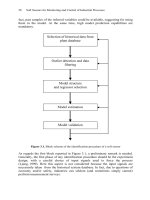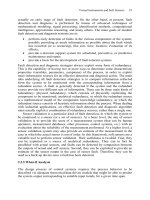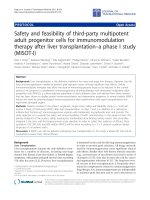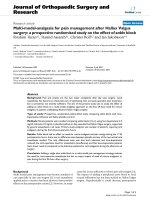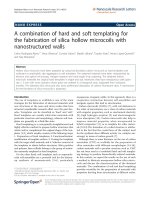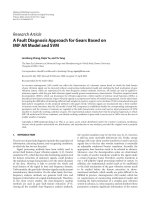Strengthening soft soil for approach road after abutment by cement and fly ash
Bạn đang xem bản rút gọn của tài liệu. Xem và tải ngay bản đầy đủ của tài liệu tại đây (1.09 MB, 14 trang )
Transport and Communications Science Journal, Vol. 71, Issue 4 (05/2020), 444-457
Transport and Communications Science Journal
STRENGTHENING SOFT SOIL FOR APPROACH ROAD AFTER
ABUTMENT BY CEMENT AND FLY ASH
Nguyen Dinh Hung
International University, VNU HCMC, Quarter 6, Linh Trung, Thu Duc, HCMC, Vietnam
ARTICLE INFO
TYPE: Research Article
Received: 29/4/2020
Revised: 21/5/2020
Accepted: 21/5/2020
Published online: 28/5/2020
/>* Corresponding author
Email: Tel: 0968069559
Abstract. Approach road is an important structure of a bridge. Serviceability of a bridge is
affected by the settlement of approach road, especially that on soft soil. One method that is
usually applied for minimizing effect of settlement of approach road is to replace soft soil by
hill soil. This method however may increase cost of projects in Mekong Delta area with a
larger depth of soft soil. In this paper, soft soil strengthened by mixing it to cement and fly ash
at different mix proportions was investigated. Test results from unconfined compression test
and direct shear test of strengthened soft soil are compared to those of hill soil to determine
the optimal mix proportion. Results showed that mixing 25kg cement and 75kg or 100kg fly
ash to 1m3 soft soil increased its unconfined compressive strength and shear strength and are
higher compared to those of hill soil. Strengthening in situ soft soil by using fly ash, industrial
waste from thermal power plant, reduces cost of project and at the same time contributes to
solving environmental problems.
Keywords: soft soil, cement, fly ash, unconfined compressive strength, shear strength, direct
shear test.
© 2020 University of Transport and Communications
1. INTRODUCTION
Approach road after an abutment as shown in Fig. 1 [1] is an important part of bridge
structures. An approach road is required for a smooth and harmonious transition from the road
to the bridge (culvert). Settlement of approach road is quite common not only in Vietnam but
444
Transport and Communications Science Journal, Vol. 71, Issue 4 (05/2020), 444-457
also in the world [2]. Settlement gradually occurs and does not cause immediate danger.
However, settlement of approach road after abutment may affect the safety of vehicles on the
bridge, impact the top wall of abutment and deck adjacent abutment, and may cause
discomfort for motorists using the bridge. There are many causes of settlement of approach
road. Basically, settlement occurs when natural ground and backfill after abutment is
consolidated. It comes from overload, increase in the number of vehicles, inadequate
compaction work, poor quality of backfill soil and having soft soil of natural ground.
Therefore, one of the ways that settlement of approach road can be avoided is by
strengthening the natural ground and backfill soil of approach road.
Figure 1. Approach road after abutment [1].
Table 1. Particle size distribution suggested for backfill [1].
No.
Opening
Finer (%)
1
90.0 mm
100
2
19.0 mm
75-100
3
4.75 mm
30-100
4
425 m
15-100
5
150 m
5-56
6
75 m
0-15
Natural ground in Mekong Delta area is a product of sedimentary process with interaction
with river and sea [3]. This type of natural ground is soft soil. This condition is a
disadvantageous to construction of structures. Therefore, the foundation of structures needs to
be strengthened. This is also true particularly for transportation projects such as road and
approach road after abutment for safety vehicles and motorist. There are many methods for
strengthening soft soil [4, 5] for approach road, such as: concrete slab combine with
reinforced concrete piles; creating consolidated soft soil by geotextile tube under vacuum
loading or sandbag combine loading; soil-cement deep mixing column; replacing soft soil
with good backfill; or using approach slab etc. Good backfill to replace soft soil for approach
road after abutment must satisfy some properties such as: a plastic index (PI) is lower than 15;
particle distribution is shown in Table 1, and uniformity coefficient, Cu is larger than 3 as
shown in Eq. (1), where D60 and D10 are diameter corresponding to 60% finer and 10% finer
those are determined based on particle size distribution curve of soil.
𝐷
𝐶𝑢 = 𝐷60
10
445
(1)
Transport and Communications Science Journal, Vol. 71, Issue 4 (05/2020), 444-457
However, transferring good soil as hill soil from other places to Mekong Delta area may
increase construction time, which in turn will increase cost of project. Strengthening soft soil
in projects in Mekong Delta area may be a good solution then as it may save construction
time and cost of project.
Several studies have been conducted on the effect of fly ash on the capacity of soft soil.
Moradi et al. [6] used bottom fly ash to enhance soft soil behaviour. Ozdemir [7] strengthened
soft soil by adding fly ash up to 10% in content. Experimental results showed that increasing
fly ash content did not increase unconfined compressive strength. In this paper, soft soil taken
from a bridge project in Mekong Delta area is strengthened by mixing to both cement and fly
ash, industrial waste from thermal power plant. The strengthened soft soil is compared to
good soil like hill soil that is designed to replace soft soil and backfill after abutment.
Different mix proportions are examined, and test results are evaluated and analysed to
propose optimum mix proportion for the project.
2. MATERIALS
2.1. Soft soil and hill soil
Figure 2. Electronic balance and sample container.
Figure 3. Test samples.
Figure 4. Dry oven.
Figure 5. Fly ash.
Soft soil was taken a bridge project in Mekong Delta area. Hill soil was designed to
replace soft soil for the project. Both type of soils were put into nylon bags and moved to
laboratory. Unit weights of both soft soil and hill soil were determined as 1677kg/m3 and
2075kg/m3, respectively. Water contents of both soils were also determined. To determine
water content, soil sample containers and electronic balance with accuracy of 0.01g as shown
in Fig. 2 were used. It was made sure that the sample containers were clean and dry before use.
Wet soil and sample containers were put into dry oven as shown in Fig. 4 at 105°C in 24h
446
Transport and Communications Science Journal, Vol. 71, Issue 4 (05/2020), 444-457
until the weight did not change. Water content of soils was determined using Eq. (2) where w1
is the weight of container, w2 is the weight of wet soil and container as shown in Fig. 3, and w3
is the weight of the dry soil and container. Water content of soft soil and hill soil is 49.49%
and 22.6%, respectively.
𝑤 −𝑤
𝑤 = 𝑤3 −𝑤2 × 100%
2
(2)
1
2.2. Fly ash and cement
Fly ash is a by-product of the combustion of pulverized coal in thermal power plants. Its
compounds includes silicon, aluminum, iron, calcium, and magnesium. Fly-ash particles are
spherical with diameter ranging from less than 1 μm to 150 μm with particles retained on 45
μm seive size of about 10%. Because its small diameter, fly ash can be added to soft soil and
fill the voids in soft soil. In this reasearch, fly ash was collected from Vinh Tan thermal power
plant as shown in Fig. 5. The collected fly ash was kept in nylon bags to ensure its moisture
content do not change during transport. The moisture content of fly ash was quite small. Fly
ash is an admixture material for concrete exposed in brackish water, sea water and sulfate
environment. So, fly ash mixed into soft soil in Mekong Delta area is suitable. In addition, it
is predicted that the by-product of thermal power plants is about 25.4 millions tons in 2020
and up to 38.3 million tons in 2030. This requires a large storage area for fly ash, unless it is
stored under the earth. Therefore, in this research fly ash added in soft soil contributes to
solving some enviromental problems. The cement used in this research is PCB40 which is
used in sulfate environment and is thus suitable for Mekong Delta area.
Table 2. Several mix proportions.
Weight / 1m3 soft soil
cement (kg)
Fly ash (kg)
0
0
0
0
Name
SS-C00-F00
HS-C00-F00
SS-C100-F00
100
0
SS-C50-F50
25
100
SS-C25-F75
25
75
SS-C25-F100
50
50
Checking time
Right after creating sample
Right after creating sample
5h after creating sample
7 days after creating sample
28 days after creating sample
5h after creating sample
1 day after creating sample
28 days after creating sample
5h after creating sample
1 day after creating sample
28 days after creating sample
5h after creating sample
1 day after creating sample
28 days after creating sample
Note: SS is soft soil; HS is hill soil; C is cement; F is fly ash
447
Transport and Communications Science Journal, Vol. 71, Issue 4 (05/2020), 444-457
3. EXPERIMENTS
In this research, soft soil and hill soil from the project were firstly compacted by standard
Proctor test [8]. Unconfined compressive strength and shear properties were then compared.
Next, soft soil was mixed with cement and fly ash at different mix proportions. Its testing
properties were then compared to those of hill soil. In soil-cement deep mixing method, the
amount of cement mixed to 1 m3 soil is from 100kg to 240kg [9, 10]. In this research, 100kg,
50kg or 25 kg cement were mixed to 1m3 soft soil. In addition, amount of fly ash of 0kg, 50kg
and 75kg or 100 kg was added. Testing properties were conducted at 5h, 1 day or 7 days and
28 days. All mix proportions are listed in Table 2.
Figure 6. Proctor machine.
Figure 8. Standard Protor equipment.
Figure 7. compaction test.
a) Hill soil sample
b) Soft soil sample
Figure 9. Compacted samples.
The density of subbase course is normally compared to the density of the compacted soil
in laboratory via Proctor machine as shown in Fig. 6. Proctor test was conducted as shown in
Fig. 7 to determine optimum water content in soil and maximum dry density of compacted
soil that is applied for subbase layer of road structures or approach road. Information of
Proctor test is shown in Fig. 8 [8]. Each sample, soil is separated into 3 layers and compacted
by 25 blows in each layer. Soft soil and hill soil were molded as shown in Fig. 9. Extruder
machine was used to remove a sample out of mold as shown in Fig. 10. Unconfined
compression test was done with universal testing machine as shown in Fig. 11 to determine
448
Transport and Communications Science Journal, Vol. 71, Issue 4 (05/2020), 444-457
shear strength of soil, cu. The loading speed applied for all specimens in unconfined
compression test was 0.1kN/s.
Direct shear test was used to determine the shear properties of soil such as cohesion, c
and friction angle . Shear ring was used to create samples as shown in Fig. 12 for direct
shear test done by test machine as shown in Fig. 13. The loading speed applied for all
specimens is 2mm/minute. The relationship of shear stress, and normal stress, based on
Coulomb theory is expressed in Eq. (3).
(3)
𝜏 = σtanφ + 𝑐
Figure 10. Extrude equipment.
a) Hill soil sample
Figure 11. Universal Testing Machine.
b) Soft soil sample
c) samples for shear test
Figure 12. Using shear ring to create samples for direct shear test.
Figure 13. Direct shear test equipment.
449
Transport and Communications Science Journal, Vol. 71, Issue 4 (05/2020), 444-457
Normally, normal stress applied for the test should not be larger than 1050 (KPa). However,
for this test, the normal stress applied for soft soil was not larger than 45kPa to avoid failure
in compression before failure in shear. After the soft soil was strengthened, normal stress may
be larger.
Mixing cement and fly ash into soft soil can be made in construction site using excavator
and soil mixer. In the laboratory, soil was mixed in containers. The amount of soft soil for one
batch was first weighed. Amount of cement and fly ash was weighed based on mix proportion
to soft soil, as well. Soft soil and cement with fly ash were mixed separately first before they
were all mixed together as shown in Fig. 14 by using Rubimix 9 as shown in Fig. 15. Rubimix
9 has powerful 1200w motor, electronic regulator of 0 to 819 rounds per minute. In the
mixing process, slow motion was selected to ensure adequate force for mixing. After mixing,
compacting and molding, samples were kept in plastic box to avoid water evaporation as
shown in Fig. 16. These samples were then subjected to unconfined compression test and
direct shear test at different time schedules. For each mix proportion, 6 samples were prepared.
The 6 samples were grouped in 3 pairs and each pair were tested in the same conditions.
a) Soft soil
b) Soft soil, fly ash and cement
Figure 15. Rubimix 9
Figure 14. Mixing soil, cement and fly ash.
a) Sample in box
b) Covering box to keep moisture
Figure 16. Boxes to keep samples.
450
Transport and Communications Science Journal, Vol. 71, Issue 4 (05/2020), 444-457
4. RESULTS AND ANALYSIS
4.1. Comparison of soft soil and hill soil without strengthening
Firstly, samples of soft soil without strengthening and hill soil as shown in Fig. 17 were
tested. Compressed hill soil samples are shown in Fig. 18. Relationship between load and
displacement of the samples are shown in Fig. 19. Results show that unconfined compressive
strength (qu) of hill soil was larger than that of soft soil without strengthening. Maximum
unconfined compressive strength of both soft soil samples was 0.3kN. Meanwhile, average
unconfined compressive strength of both hill soil samples was 0.5kN. It means that the
unconfined compressive strength of hill soil was larger than that of soft soil. Fig. 19 also
shows that stiffness of hill soil was a little bit larger than that of soft soil. Therefore,
replacement of soft soil by hill soil in subbase course of road or approach road after abutment
can increase stability and reduces settlement.
4.2. Soft soil strengthened with 100kg cement
Previous results show that the bearing capacity of soft soil was smaller than that of hill
soil. To reduce cost due to usage of hill soil and its transportation, soft soil can be used as
subbase course instead. In that case, soft soil needs to be strengthened. Mix proportion of
100kg of cement to soft soil was prepared. Fig. 20 shows relationship between applied force
and displacement of samples of the mix in unconfined compression test. The tested
unconfined compressive strength of each pair at 5h and 7 days was quite similar, while the
strengths of pair at 28 days were different. Unconfined compressive forces of the tested
samples of this mix proportion are listed in Table 3. The average unconfined compressive
forces at 5h was 1.475kN. This average value was much higher than that of hill soil, 0.5kN.
At 5h, the strength of strengthened soft soil was 2.95 times larger than that of hill soil.
Average unconfined compressive forces of soft soil strengthened at 7 days and 28 days was
3.15kN and 4.475kN, respectively. It means that, unconfined compressive forces of
strengthened soft soil at 7 days and 28 days were 6.5 times and 8.95 times greater than that of
hill soil, respectively. Fig. 21 shows failure of strengthened soft soil at 28 days. It is
recognized that the sample failed in a brittle way, different from hill soil which failed in a
plastic way as shown in Fig. 18. It can be confirmed from these test results that adding 100kg
cement to soft soil for subbase layer of road or approach road after abutment improved the
stability and strength of subbase course. Therefore, soft soil can be recycled to reduce cost of
project.
Figure 17. Soft soil and hill soil.
Figure 18. Failure of hill sample.
451
Transport and Communications Science Journal, Vol. 71, Issue 4 (05/2020), 444-457
0.6
Force (kN)
0.5
0.4
SS-C00-F00-1
0.3
SS-C00-F00-2
0.2
HS-C00-F00-1
0.1
HS-C00-F00-2
0
0
10
20
30
40
Displacement (mm)
50
Figure 19. Relationship between applied force and displacement of soft soil and hill soil.
Table 3. Unconfined compressive force of SS-C100-F00 and SS-C50-F50.
Checking
time
No.
1
2
3
4
5
6
7
8
5h
1 day
7 days
28 days
6
SS-C100-F00-5h1
SS-C100-F00-5h2
5
Force (kN)
Applied force (kN)
SS-C100-F00
SS-C50-F500
Each sample
Average Each sample Average
1.35
1.05
1.475
1.05
1.60
1.05
1.50
1.65
1.75
3.00
3.15
3.30
5.00
3.95
4.475
3.945
3.94
-
SS-C100-F00-7d1
4
SS-C100-F00-7d2
3
SS-C100-F00-28d1
2
SS-C100-F00-28d2
1
0
0
5
10 15 20 25
Displacement (mm)
30
35
Figure 20. Unconfinement compression test of
samples SS-C100-F00.
Figure 21. Failure of SS-C100-F00-28d.
4.3. Soft soil strengthened with 50kg cement and 50kg fly ash
Using 100kg of cement for 1 m3 soft soil was proven to increase unconfined compressive
452
Transport and Communications Science Journal, Vol. 71, Issue 4 (05/2020), 444-457
strength of soil. The strength of strengthened soft soil was much higher than that of hill soil
that was designed to replace soft soil. However, using 100kg of cement may be wasteful or
costly. Reducing cement content and substituting a part of it with fly ash may reduce the cost
of project. In this mix proportion, 50kg of cement and 50kg of fly ash for 1m3 of soft soil
were examined. Fig. 22 shows the results of the unconfined compression test. It seems that at
1 day, sample also failed in a brittle way. Fig. 23 shows relationship between applied load and
displacement of samples in this mix proportion at different testing times. Unconfined
compression forces are also listed in Table 3. At 5h, unconfined compressive strength was
1.05kN which was smaller than that of soft soil strengthened with 100kg cement. But it was
still 2.1 times larger than that of hill soil. In this mix proportion, the sample at 1 day was
tested, but not same at 7 days as SS-C100-F00. Average tested force at 1 day was 1.625kN,
3.25 times larger than that of hill soil. At 28 days, only one sample was tested. Another
sample was broken in the moving process. However, at 28 days, unconfined compressive
force of the mix proportion was 3.95kN, 7.9 times larger than that of hill soil. This value was
about 88.3% of that of mix proportion using only 100kg cement. The strength of subbase
course using 50kg cement and 50 kg fly ash for 1 m3 soft soil, at 5h after constructing, might
be higher than that of hill soil. Obviously, cost of 50kg fly ash is lower than that of 50kg
cement. So, this mix proportion is cheaper than the mix proportion using 100kg cement only.
4
SS-C50-F50-5h1
SS-C50-F50-5h2
SS-C50-F50-1d1
SS-C50-F50-1d2
SS-C50-F50-28d
Force (kN)
3.5
3
2.5
2
1.5
1
0.5
0
0
Figure 22. Failure of SS-C50-F50-1d.
5
10
15
Displacement (mm)
20
Figure 23. Unconfinement compression test of
samples SS-C50-F50.
4.4. Soft soil strengthened with 25kg cement and 75kg or 100 kg fly ash
Sample SS-C50-F50 showed that its strength was still higher than that of hill soil. To
reduce more cost, the weight of cement could be decreased, and the amount of fly ash could
be increased. In this mix proportion, 25kg of cement and 75kg or 100kg of fly ash for 1m3
soft soil were tested. Fig. 24 and Fig. 25 show failure of samples with 25kg cement and 75kg
or 100kg fly ash under unconfined compression tests at 5h. Fig. 26 shows the relationship
between applied load and displacement of these mix proportions. Maximum applied force of
these specimens is listed in Table 4. Unconfined compressive force of these mix proportion
was a little bit larger than that of hill soil at 5h and 1 day. However, at 28 days, tested
unconfined compressive force was still approximately 4 times larger than that of hill soil. Test
result of samples using 75kg fly ash was similar to 100kg fly ash. Reducing the amount of
cement to 25kg also reduced unconfined compressive strength of strengthened soft soil
compared to using 50kg or 100kg cement. However, the strength of samples using 25kg
453
Transport and Communications Science Journal, Vol. 71, Issue 4 (05/2020), 444-457
cement and 75kg or 100 kg fly ash was still higher than that of hill soil. The strength of
samples using 100kg fly ash was a little bit larger than that using 75kg fly ash. Using 100kg
fly ash increases the cost of the project to compare to 75kg fly ash. However, requirements of
large storage for fly ash at a thermal power plant are currently a big challenge. Therefore,
using 100kg fly ash has more environmental rewards aside from resulting to more
improvement of the subbase course.
4.5. Analysis about unconfined compressive strength
In generally, adding cement and fly ash into soft soil increased its unconfined
compressive strength. Percentage of strength increase depends on the amount of cement and
fly ash. Testing results show that increase the amount of cement added to soft soil increases its
strength.
Figure 24. Failure of SS-C25-F75-5h.
Figure 25. Failure of SS-C25-F100-5h.
2.5
2.5
SS-C25-F75-5h1
SS-C25-F75-5h2
SS-C25-F75-1d1
SS-C25-F75-1d2
SS-C25-F75-28d
1.5
SS-C25-F100-5h
SS-C25-F100-1d
SS-C25-F100-28d1
SS-C25-F100-28d2
2
Force (kN)
Force (kN)
2
1
0.5
1.5
1
0.5
0
0
0
10
20
30
40
Displacement (mm)
50
0
a) Sample SS-C25-F75
5
10 15 20 25
Displacement (mm)
30
b) Sample SS-C25-F100
Figure 26. Unconfinement compression tests of samples with 25kg cement.
Table 4. Unconfined compressive force of SS-C25-F75 and SS-C25-F100.
No.
1
2
3
4
5
6
Checking
time
5h
1 day
28 days
Applied force (kN)
SS-C25-F75
SS-C25-F100
Each sample
Average
Each sample
Average
0.65
0.70
0.65
0.70
0.65
0.70
0.75
0.75
0.75
0.8
1.5
1.75
1.5
1.90
2.05
454
Transport and Communications Science Journal, Vol. 71, Issue 4 (05/2020), 444-457
Unconfined compressive strength of the mix proportion using 25kg cement and 75kg or
100kg fly ash at 5h was larger than that of hill soil. The strength at 28 days was approximately
4 times higher than that of hill soil. Its stiffness was also higher than that of hill soil. The
increase in strength and stiffness of strengthened soft soil is contributed by not only cement
but also fly ash. Fly ash with small spherical particle size can fill the void in soft soil. Fly ash
with larger surface area could absorb water in soft soil and contributing as aggregate in mortar
with cement. Therefore, using 25kg cement and 100kg fly ash increases the strength of soft
soil and reduces cost of the project.
4.6. Shear strength
Soil sample taken from construction site was tested as remold. After compacting, the
subbase course was also tested for shear strength properties such as cohesion, c and friction
angle . Test results showed that cohesion of soft soil and hill soil was zero due to
consolidation. Friction angle of soft soil and hill soil was 31° and 68°, respectively. These
values were quite large. Each type of soil, soft soil and hill soil, was tested by two normal
stress values of 30kPa and 45 kPa. Therefore, the accuracy may not be high. For soft soil
strengthened with 25kg cement and 75 kg fly ash, shear properties were tested at 1 day.
Normal compressive stresses acting on samples were 30kPa, 45kPa and 60kPa, respectively.
Relationships between shear stress and displacement at each normal stress are expressed in
Fig. 27. Relationship between shear stress and normal stress Fig. 27. Relationship between
shear stress and normal stress is shown in Fig. 28. Trendline passing through 3 points is
created to determine shear properties. Trendline shows that cohesion, c is negative, but it is
closed to zero. It is because accuracy of the test was not high. Theoretically, cohesion is zero
because of consolidated soil. Friction angle was determined as 54.5°. To compare soft soil,
friction angle of strengthened soft soil is much larger than that of unstrengthened soft soil.
However, this value was still smaller than that of hill soil.
a) Normal stress = 30kPa
b) Normal stress = 45kPa
c) Normal stress = 60kPa
Figure 27. Direct shear test of SS-C25-F75-1d.
455
Transport and Communications Science Journal, Vol. 71, Issue 4 (05/2020), 444-457
Figure 28. Predicting failure envelop line of SS-C25-F75-1d.
5. CONCLUSIONS
Recently, many construction projects have been carried out to improve infrastructure,
especially in Mekong Delta area. The natural ground in Mekong Delta area has been formed
from sedimentary process. This is mainly soft soil ground which needs to be strengthened
before use in construction projects in this area, especially in road and approach road after
abutment. There are many methods to strengthen soft soil. One of usual practice is to replace
soft soil with good soil such as hill soil. However, this may increase cost of the project by
transportation fee and cost of hill soil. To reduce project costs, soft soil at the project may be
strengthened by mixing with cement and fly ash from thermal power plant. In this paper,
several mix proportions were tested. The properties of strengthened soft soil such as
unconfined compressive strength and internal friction angle increased when the amount of
cement mixed into soft soil was increased. Larger content of cement could increase cost of
projects. Results showed that the unconfined compressive strength of sample mixing 25kg
cement and 75kg or 100 kg fly ash into 1m3 soft soil were a little bit larger than that of hill
soil at 5h and approximately 4 times larger than that of hill soil at 28 days. In order to save
money for storing fly ash, an industrial waste from thermal power plant, mix proportions of
25kg cement and 100 kg fly ash is recommended for projects with soft soil.
REFERENCES
[1]. Decision No. 3095/QD-BGTV dated October 7th, 2013 regarding issuance of the provisional
regulation on technical technology solution transition embankment sections between the road and the
bridge (culvert) on the highway, 2013 (in Vietnamese).
[2]. Nguyen Trung Hong, Tran Tien Dung, Causes settlement of approach road after abutment –
Specifications for designing approach road, Symposium of Information for design, The Transport
Engineering Design Incorporated, pp.33-43, 2nd Quarter, 2013 (in Vietnamese).
[3]. Truong Minh Hoang, Nguyen Van Lap, Ta Thi Kim Oanh, Takemura Jiro, Changes in late
Pleistocene–Holocene sedimentary facies of the Mekong River Delta and the influence of sedimentary
environment on geotechnical engineering properties, Journal of Engineering Geology, 122 (2011) 146159. />[4]. M. Bilal, A. Talib, A study on advances in ground improvement techniques, National Conference
on Advances in Geotechnical Engineering, (2016).
/>456
Transport and Communications Science Journal, Vol. 71, Issue 4 (05/2020), 444-457
IMPROVEMENT_TECHNIQUES
[5]. H. Elbadry, A.Eid, Simplified technique achieving low cost and high-performance impact for
construction in very deep very soft ground sites, Housing and Building National Research Center
Journal, 14 (2016) 56-65. />[6]. Moradi, R., Marto, A., Rashid, A.S.A. et al., Enhancement of Soft Soil Behaviour by using
Floating Bottom Ash Columns. KSCE Journal of Civil Engineering 23 (2019) 2453–2462.
/>[7]. M. A. Ozdemir, Improvement in bearing capacity of a soft soil by addition of fly ash, Procedia
Engineering Journal, 143 (2016) 498-505.
[8]. Braja M. Das, Principle of geotechnical engineering, 7th Edition, Cengage Learning, 2010.
[9]. J. C. Chai, N. Miura, H. Koga, Lateral displacement of ground caused by soil-cement column
installation, Journal of Geotechnical and Geoenvironmental Engineering, 131 (2005) 623-632.
/>[10].A. Farouk, M. Shahien, Ground improvement using soil–cement columns: Experimental
investigation,
Alexandria
Engineering
Journal,
52
(2013)
4733-740.
/>
457

